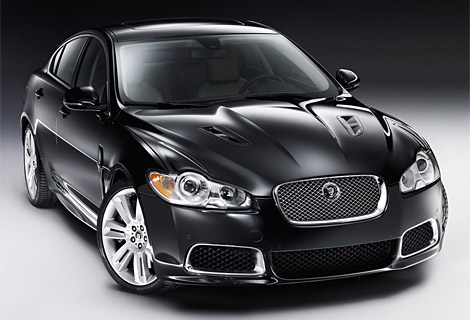 It's not a stretch to say the Jaguar XF is the car that has reshaped and reinvigorated the brand -- its S-Type predecessor a distant memory. In a recent comparison, we ranked the XF above its BMW, Benz and Lexus competitors. It was a serious contender for the 2009 Car of the Year. Despite the occasional niggle, we're enamored of the Jag sedan.Now, with the 2010 Jaguar XFR, the crew in Coventry has gone and made the XF even better. The hottest XF gets more power, but at no loss in fuel economy. It's stronger -- with more rakish looks -- and the R-rated feline is sure to be a more involving drive.The XFR receives a new, direct-injected 5.0L V-8 (also available for the 2010 XF). But the XFR's mill receives pressurization from a Roots-type, twin-intercooled supercharger. Despite a mighty output of 510 hp and 461 lb-ft of torque, the new engine comes sans weight or fuel mileage penalty -- its 15/23-mpg rating is the same as the outgoing supercharged 4.2L. Jaguar attributes this to a variety of new and altered components, including a direct-injection system, a variable-length intake manifold, and variable camshaft timing.The new cam timing system relies on forces generated by the valves, rather than by oil pressure. The oil pump has been decreased in size and relocated as a result, reducing engine length by 0.94-in. These new technologies allow Jaguar to raise the compression of the engine to 9.5:1 (up from 9.1:1 on the 4.2L). Service intervals have been lengthened to 15,000 miles as well.To transmit the engine's enthusiasm to the ground (and the driver), Jaguar employs two new electronically controlled systems in the XFR. The first, Active Differential Control, varies torque between the rear wheels depending on the surface. It attempts to prevent excessive wheel slip, but does not impede slippage with brake application. The press materials read: "The traditional, mechanical differential can compromise stability under hard applications of power, demanding more corrective input from the driver." Translation: This Jag allows easy power slides.The second, Adaptive Dynamics, attempts to control the vertical movement, roll rate, and pitch rate of the chassis by analyzing the rates and adjusting the dampening to compensate. It can also predict rates based on driver inputs -- whether you're chucking the steering wheel in one direction or stomping on the 14.9-in. front brakes -- and preemptively adjust.
It's not a stretch to say the Jaguar XF is the car that has reshaped and reinvigorated the brand -- its S-Type predecessor a distant memory. In a recent comparison, we ranked the XF above its BMW, Benz and Lexus competitors. It was a serious contender for the 2009 Car of the Year. Despite the occasional niggle, we're enamored of the Jag sedan.Now, with the 2010 Jaguar XFR, the crew in Coventry has gone and made the XF even better. The hottest XF gets more power, but at no loss in fuel economy. It's stronger -- with more rakish looks -- and the R-rated feline is sure to be a more involving drive.The XFR receives a new, direct-injected 5.0L V-8 (also available for the 2010 XF). But the XFR's mill receives pressurization from a Roots-type, twin-intercooled supercharger. Despite a mighty output of 510 hp and 461 lb-ft of torque, the new engine comes sans weight or fuel mileage penalty -- its 15/23-mpg rating is the same as the outgoing supercharged 4.2L. Jaguar attributes this to a variety of new and altered components, including a direct-injection system, a variable-length intake manifold, and variable camshaft timing.The new cam timing system relies on forces generated by the valves, rather than by oil pressure. The oil pump has been decreased in size and relocated as a result, reducing engine length by 0.94-in. These new technologies allow Jaguar to raise the compression of the engine to 9.5:1 (up from 9.1:1 on the 4.2L). Service intervals have been lengthened to 15,000 miles as well.To transmit the engine's enthusiasm to the ground (and the driver), Jaguar employs two new electronically controlled systems in the XFR. The first, Active Differential Control, varies torque between the rear wheels depending on the surface. It attempts to prevent excessive wheel slip, but does not impede slippage with brake application. The press materials read: "The traditional, mechanical differential can compromise stability under hard applications of power, demanding more corrective input from the driver." Translation: This Jag allows easy power slides.The second, Adaptive Dynamics, attempts to control the vertical movement, roll rate, and pitch rate of the chassis by analyzing the rates and adjusting the dampening to compensate. It can also predict rates based on driver inputs -- whether you're chucking the steering wheel in one direction or stomping on the 14.9-in. front brakes -- and preemptively adjust.The Greet Jaguar XFR





